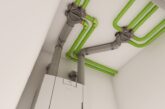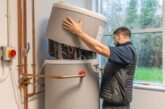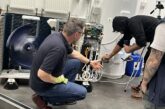
Jonathan Ducker, Head of Regulatory Affairs at Kingspan Insulation explains why you need to insulate before considering a heat pump installation.
This April, the Government is looking to kick start the heat pump revolution with its new Boiler Upgrade Scheme, offering grants of up to £5,000 to cover the switch from gas to electric. Whilst the overall budget for the scheme is limited, it still means that for the first time, heat pumps will be a more affordable option for a lot of homeowners. To get these units to perform well, however, and ensure they are affordable to operate, you need to take a careful look at how well insulated the house is.
Why heat pumps?
The switch to heat pumps is all part of the effort to make the country Net Zero Carbon by 2050. The energy used in our homes makes up about 14 per cent of emissions[1] and a lot of that is down to heating. The Government’s plan is to switch building heating from fossil fuels to electricity. At the same time, they’re looking to add more renewable generation to the National Grid with the aim of fully decarbonising it by 2035. Heat pumps are a key part of this due to their efficiency.
Heat pumps work by extracting heat either from the outdoor air (air source) or through pipes buried in the ground (ground source). This heat is used to evaporate a refrigerant which is then pressurized – creating more heat. Whilst new boilers are around 92 per cent efficient, ground source heat pumps can reach efficiencies of 300 per cent or more. This makes them a lot more affordable to run than direct electric alternatives.
Why you need to insulate first
The main challenge when fitting a heat pump is that they work best at lower temperatures than gas systems. Whilst gas boilers are often designed to operate at 65°C – 75°C, heat pumps work more efficiently at 55°C or below. This is why it’s often a good idea to fit underfloor heating with them to spread the heat more evenly across rooms.
Obviously, this change also means it’s important to keep in as much heat as possible. This is especially important with air source heat pumps as they must work harder to generate heat in the winter due to the cooler air temperature. If the building then wastes a lot of this heat, it can lead to big heating bills or make it difficult to get homes warm.
To show how much difference this makes, we carried out some energy modelling on three typical houses (below). As you can see, the heating bills for the solid walled house are more than three times that of the properly insulated home, so it pays to get it right
| If heated by a 250 per cent efficient air source heat pump | ||
| Efficiency adjusted kWh/yr demand | £/year (electric) | |
| Solid walled house with no insulation (energy demand: 17000 kWh/year); | 6800 | 1183.20 |
| Average existing house with no insulation (energy demand: 11000 kWh/year); | 4400 | 765.60 |
| Existing home with properly insulated walls, roof and floors (energy demand: 5000 kWh/year) | 2000 | 348.00 |
Creating a plan
When insulating the building, the package really needs to be designed around the specific house. Factors such as the home’s design, location and the constructions used for the walls, floor and roof will impact the best solution. Before you fit anything, you’ll need to find and deal with any existing issues such as damp. Keep in mind also that any insulation you fit will make the building more airtight. This means you’ll need to fit more ventilation, particularly in bathrooms or kitchens.
Given these complexities, if a customer is looking at getting a heat pump fitted, it’s a good idea to work with a Retrofit Coordinator and carry out the improvements to PAS 2035:2019. This is a public specification which sets out a clear process for assessing a home, dealing with any issues and developing a medium-term improvement plan which details the best order for installing the improvements. The installation and commissioning will then need to be carried out to PAS 2030:2019, meaning you’ll need to get yourself qualified under the scheme. The best way to do this is by becoming TrustMark Registered.
Whilst this can be a bit costly, and means you need to be audited annually, it’s a good way to check you’re up-to-date with best practice. It’s also likely to be an essential requirement for any future government funded schemes, so if you’re planning on carrying out insulation retrofits in the future, it makes sense to get on board.
You can find more information about the scheme and training providers at www.trustmark.org.uk
Getting the right results
The switch to heat pumps is going to mean lots of energy retrofits will be needed in the next few years. By getting qualified under PAS 2030:2019, you can keep yourself up to speed with latest changes, deliver good value to customers and ensure you’re in the best position to take advantage of any future government funding schemes.
For further information on Kingspan visit https://www.kingspan.com/group/







